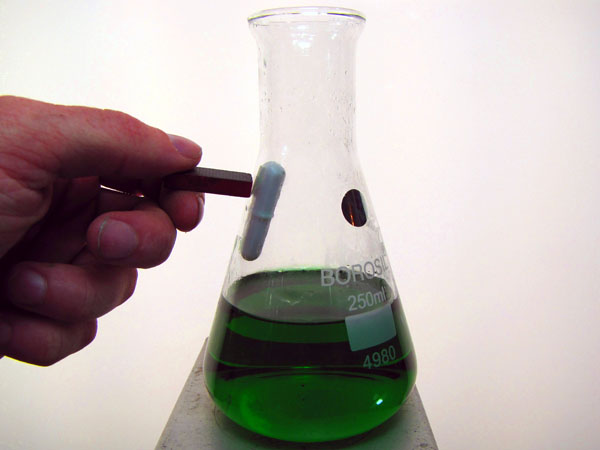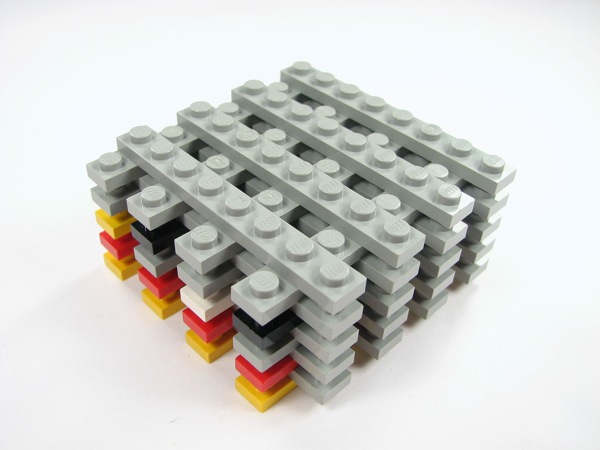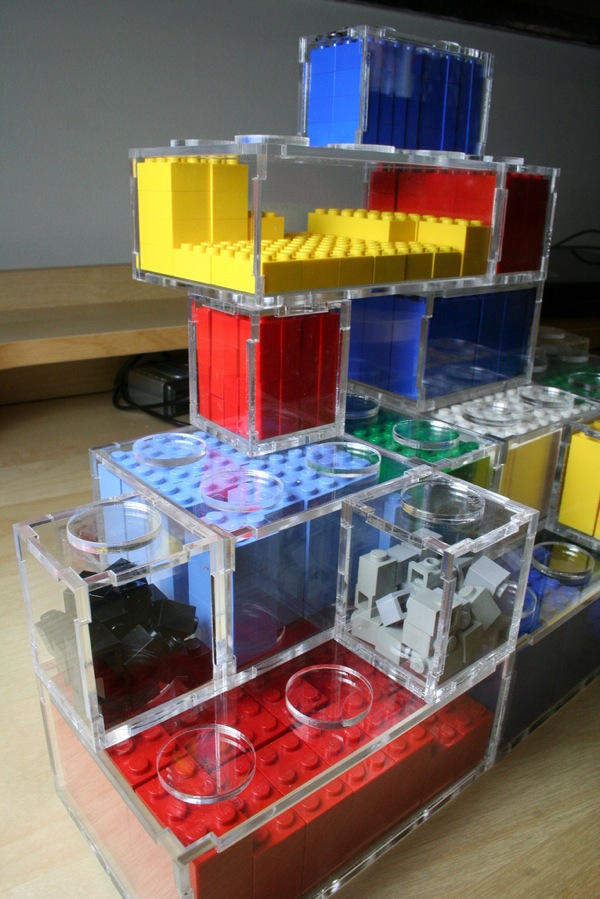Top 10: Tips for the Amateur Chemist:
We have featured projects from teenage chemist Hayden Parker, who is this semester an entering freshman at Willamette University, several times since he first showed up on our radar at Bay Area Maker Faire 2011. We recently asked Hayden to share some of the most useful practical tips he’s picked up from the home and hobby chemistry community, and this list is the result. Thanks, Hayden! Keep up the good work! – Ed.
#10

Holding stir bars with magnets
Stirring solutions on a magnetic stirrer is one of the most common things you do in a home lab, and it’s usually followed by pouring that solution. Having the stir bar pour out with the liquid is a bit annoying, but easy to fix. Use a magnet to hold the bar to the bottom of the beaker and the problem is solved. Powerful and small magnets can be taken from old or broken hard drives, and are very effective for this.
#9

Desiccation made easy
Some compounds cannot be dried by letting them stand in air or with gentle heating, as they are hygroscopic, deliquescent, or decompose. The answer to this problem is desiccation. Rather than buying an expensive lab vacuum desiccator, you can simply make a desiccator bag. To do this place the compound you wish to dry in a plastic bag with a beaker of your favorite desiccant. In my experience sodium hydroxide has worked very well, but anhydrous calcium chloride or magnesium sulfate can also be used. Let them sit until all the water has been pulled out of your compound and into the desiccant. This video from NurdRage illustrates the technique well.
#8

Sand bath
Very often in the home lab you will need to heat a flask for distillation or refluxing. When temperatures exceed 100C, oil baths are the conventional choice. Oil, however, can be very messy, and very dangerous when hot. It is also volatile and if heated too much can ignite. Sand baths are a good alternative. Rather than surrounding your flask with oil, place sand in the heating mantle. It does a good job of transferring heat, while presenting less danger and almost no mess.
#7

Science made alive
Science made alive is a science website with a focus on chemistry. Countless experiments can be found there, all with high quality photography and in-depth explanations. Almost all can be repeated by most home chemists and are very instructive.
#6

Plastic dip
Home chemists use all sorts of metal tools such as tongs and pliers, which often become rusted over time with exposure to various corrosive chemicals. An easy fix is to coat them with plastic dip. Plastic dip is a rubber liquid that can be purchased at most hardware stores. Simply dip the handles on your tools in the rubber, and hang it to dry. After it dries your tools will have a protective rubber coating that can be removed with a knife if needed.
#5

Refrigerators
Old or broken refrigerators make ideal storage units for chemicals, especially if you work outside. They have many configurable shelves and are white inside, making it easy to see and find things. Due to their insulation they can hold in fumes that would cause undesirable odors, and can protect from light and extreme temperatures. My lab was outside so having two nonfunctional mini refrigerators was a life saver. These refrigerators should not be given power unless they are designed to be “explosion-proof,” however, as the electrical components may ignite the fumes of volatile chemicals.
#4

Removing stuck glass joints
Often when working with glass joints they can become impossibly stuck together. A few methods exist to try to separate them. First, adding a few drops of toluene around the joint will often do the trick. The toluene seeps into the glass and can loosen the joint. If that doesn’t work gently heat the joint with a heat gun for under a minute, then tap on the glass softly with a lightweight tool. After a few tries the glass should fall free. Just be sure you have prepared a soft place for it to land.
#3

Wrapping glass bottles
With very few exceptions, glass is chemically inert and is often the choice for storing harmful chemicals. However, glass bottles are fragile, and when they do break it can be quite a mess. Wrapping your glass containers with plastic wrap or packaging tape helps this problem quite a bit. If the glass were to fracture the shards will be contained and, in the case of solid chemicals, much of the contents, as well.
#2

Buy chemicals locally
Many chemicals can be purchased at local grocery stores or hardware stores. These chemicals are often of sufficient purity for lab use and are generally much cheaper than buying from a chemistry website. Examples include solvents such as acetone and toluene, which can be purchased at any hardware store. This page is a good resource for finding retail sources of various chemicals.
#1

Sciencemadness
Sciencemadness.org is an online forum for amateur chemistry and one of the best resources for the home chemist. The forum has been active since 2002 and today has over 10,000 members. Many members are accomplished chemists with professional backgrounds, and are very supportive and happy to help.



















